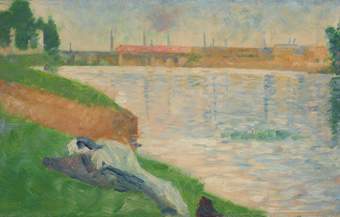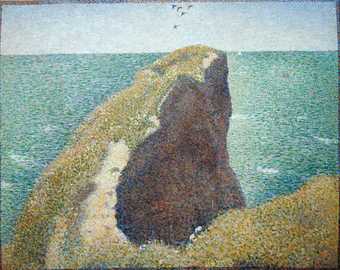Artist biography
French painter of figures and . Born in Paris. Studied at a municipal school under the Justin Lequien. Then worked 1878-80 at the in the studio of Lehmann, a pupil of Ingres. Copied and drawings by Ingres and Holbein; studied the works of Delacroix and the colour theories of Chevreul, Charles Blanc, O.N. Rood and Charles Henry. Concentrated 1881-3 on drawing, especially in conté crayon, then began to analyse colours into their components (Divisionism) and lay them on side by side in small brush-strokes (Pointillism). Helped to found the Société des Artistes Indépendants in 1884, and met Signac, Cross and Angrand. From 1885 spent almost every summer on the Normandy coast at Grandcamp, Honfleur, etc.; series of coast scenes. Figure , sometimes of large dimensions, during the winter months. Exhibited at the last exhibition of 1886. His late works showed increasing stylisation akin to . Died in Paris.
Published
in:
Ronald Alley, Catalogue of the Tate Gallery's Collection of Modern Art other than Works by British Artists, Tate Gallery and Sotheby Parke-Bernet, London 1981, p.681
Wikipedia entry
Georges Pierre Seurat (UK: SUR-ah, -‚ÅÝ…ô, US: suu-RAH; French: ∞⁄œÙ…î Ŝ٠±Ë¬·…õ Å ≤ı≤’ Å≤π±’; 2 December 1859 ‚Äì 29 March 1891) was a French post-Impressionist artist. He devised the painting techniques known as chromoluminarism and pointillism and used cont√© crayon for drawings on paper with a rough surface.
Seurat's artistic personality combined qualities that are usually thought of as opposed and incompatible: on the one hand, his extreme and delicate sensibility, on the other, a passion for logical abstraction and an almost mathematical precision of mind. His large-scale work A Sunday Afternoon on the Island of La Grande Jatte (1884–1886) altered the direction of modern art by initiating Neo-Impressionism, and is one of the icons of late 19th-century painting.
This biography is from Wikipedia under an . Spotted a problem? Let us know.



